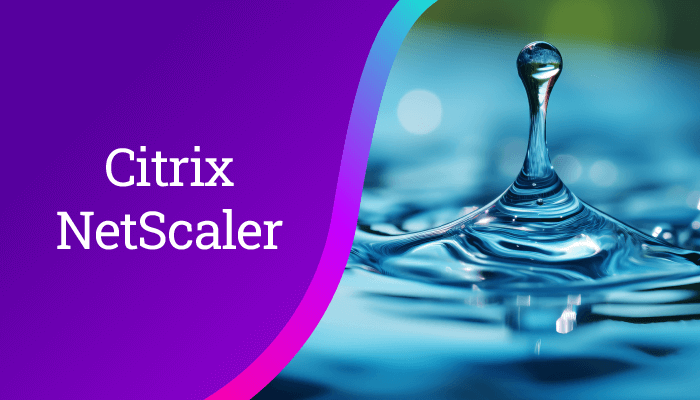
Navigating the complexities of Citrix NetScaler pooled licensing
Published on •4 minsLet's begin by stating that this blog is not here to slate Citrix NetScaler. It is a robust and feature-rich product, suitable for large businesses.
My objective is merely to offer an opinion on the complexities of their pooled licence and highlight some important considerations to be aware of.
The confusion caused by NetScaler's pooled license
Pooled licensing load balancer options such as Citrix NetScaler's (MPX/SDX) Bandwidth Pools, claim to offer users the ultimate flexibility to choose what resources they want to use, when, and where — helping them scale as needed:
"NetScaler Pooled capacity allows you to share bandwidth or instance licenses across different NetScaler form factors."
It sounds simple enough, right? But in reality, you need a manual to figure out billing and usage allowances. They have one publicly available here if you have your detective hat on.
Citrix NetScaler billing complexities
Okay, so let's look at how 'simple' it is to buy a NetScaler hardware load balancer. To start with, you have six steps:
- Buy a Zero-Capacity Hardware Appliance
- Buy a Hardware Maintenance Contract
- Buy a supported Network Adaptor
- Buy a Customer Success Service
- Buy a Starter Pool Subscription
- Buy an Add-on Bandwidth (per Gbps)
Is that all? What about services, including installation assistance or consultation, training, and certifications...? Remember, Citrix NetScaler also requires another expenditure layer, breaking down Support into multiple flavors or 'Editions': Standard (now EOS), Advanced, and Premium.
NetScaler load balancer billing example
Let's use only the cheapest and most expensive options for a better comparison, taking real-world examples from the 2019 Citrix Pricebook (source: Quick Reference Pricing Sheet, March 2019).
I'm only going to look at the single-tenant hardware for comparative purposes.
Comparison 1: Citrix NetScaler MPX
Specifications:
- 8900Z Series (MPX)
- Standard Edition
- 5 Gbps Pool
- 1-Year Subscription (not including Hardware Warranty Extension, WAF, or any additional add-ons - including a network card)
Pricing:
- Hardware = $12,000
- Software Pool = $12,000 (1-Year Subscription)
That's $24,000 for a single appliance. But you need two to make an HA pair, so in total that's $48,000 for comparison purposes (assuming you'd want to use the entire 5GB pool on each ADC).
Comparison 1: Loadbalancer Enterprise Prime
Specifications:
- Loadbalancer Enterprise Prime
- Standard 1 Year 24/7 Support
- 3 Year Hardware Warranty
- WAF
- GSLB
Pricing:
- Hardware = $4,995
- Software Support = $1,250 (annually)
That's $6,245 for a single appliance, and $12,490 for an HA pair.
That's a whopping 74% saving from year 1, and 90% saving year over year.
Did I mention the Enterprise Prime also includes a zero end-of-life policy and freedom license, allowing you to migrate to a new hardware, virtual appliance, or cloud platform anytime?
Let's take another example...
Comparison 2: Citrix NetScaler MPX
Specifications:
- 25000Z Series (MPX)
- Premium Edition
- 100 Gbps Pool
- 1-Year Subscription (not including Hardware Warranty Extension, WAF, or any additional add-ons - including a network card)
Pricing:
- Hardware = $85,000
- Software Pool = $70,000
That's $155,000 for a single appliance, and $310,000 for an HA pair (assuming you'd want to use the entire 100Gb pool on each ADC).
Comparison 2: Loadbalancer.org Enterprise Max
Specifications:
- Standard 1 Year 24/7 Support
- 3 Year Hardware Warranty
- WAF
- GSLB
Pricing:
Hardware = $20,995
Software Support = $5,250 (annually)
That's $26,245 for a single appliance and $52,490 for an HA pair.
That's a whopping 84% saving from year 1, and a 99.25% saving year over year.
Comparison takeaways
We saw that in comparison one, Loadbalancer offered a whopping 74% saving from year 1, and 90% saving year over year.
And in comparison two, the saving was 84% from year 1, and a 99.25% saving year over year.
Summary
Okay, so you can hopefully see now that, despite their claims, Citrix NetScaler is far above industry standard pricing. But you may still be convinced that the pooled licensing model is best for your business.
So, let's assume you want to know what Loadbalancer.org offers to support you in this regard...
We believe in simplicity and cost transparency. After all, who wants to keep track of physical licenses, virtual licenses, and pooled and instance capacities, and pay a massive premium for the privilege? I personally don't believe that any business, no matter how large, should spend millions of dollars per year on load balancing!
Instead of remembering your pool capacity, why not opt to go unlimited with Loadbalancer's Enterprise Site License for true flexibility and freedom, allowing you to do as you choose without the risk of cost creep? A simple option, at an unbelievable price.
Here's what's on offer:
Enterprise Site and Global Site Licenses
- You get all the instances you need, unlimited capacity, and a single fixed cost (the best value on the entire market, guaranteed).
- Zero EOL policy and freedom to migrate across platforms free of charge.
- Available as Perpetual OR Subscription.
Single Site License
- Unlimited ADCs at a single site or data center
- Perpetual License Cost: $23,970
- Annual Support Fee: $6,000; OR
- Available as a monthly subscription from just $1,080 per month
Global Site License
- Unlimited ADCs at the main sites or data centers you want, forever!
- Perpetual License Cost: $143,820
- Annual Support Fee: $36,000; OR
- Available as a monthly subscription from just $6,480 per month
Regardless of the licensing you're looking for, it's definitely worth shopping around for greater flexibility and cost savings.
So, what are you waiting for? Why not contact us to explore your options, and see just how much money you could save?!
